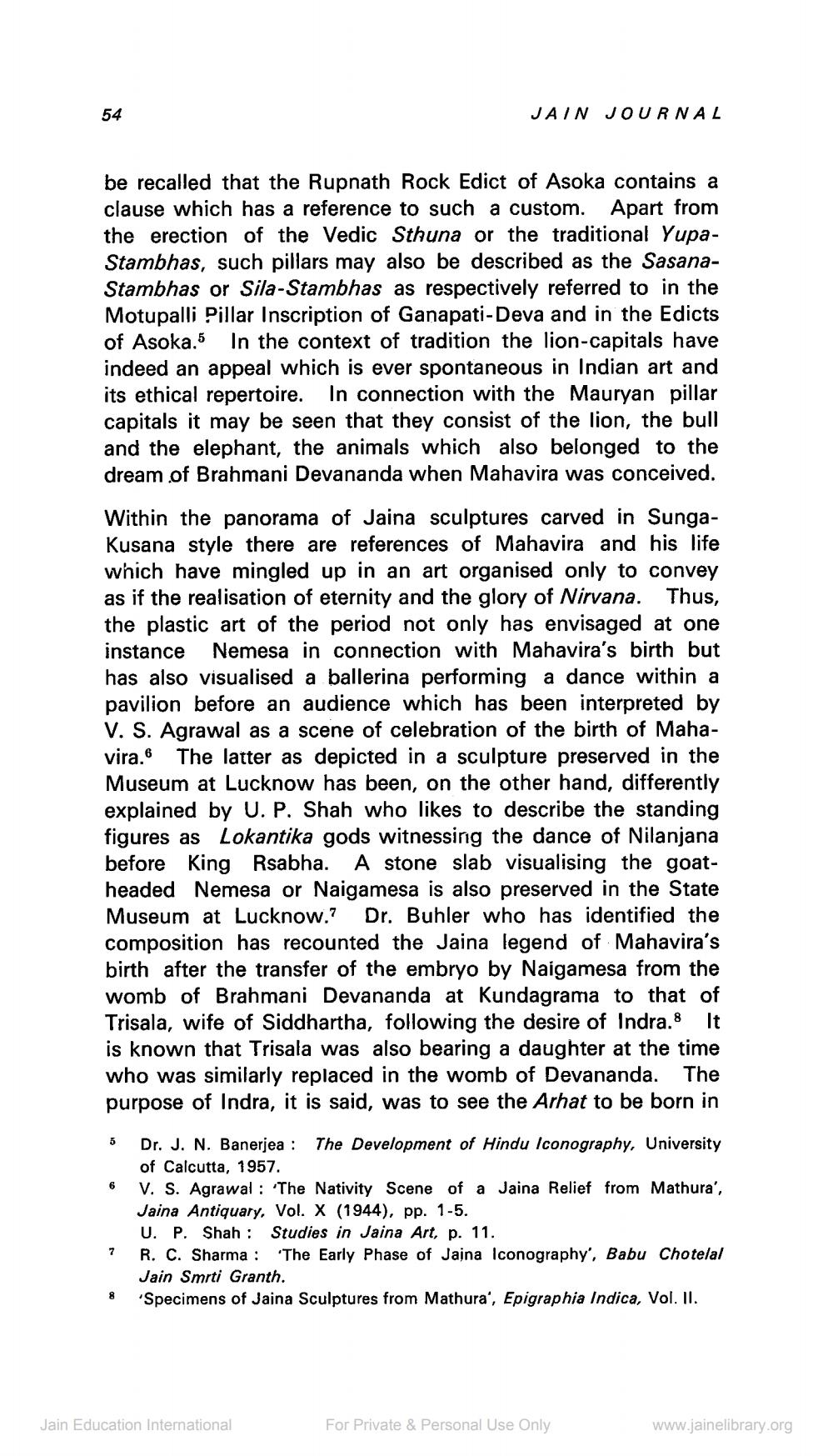Book Title: Jain Journal 1974 10 Author(s): Jain Bhawan Publication Publisher: Jain Bhawan Publication View full book textPage 6
________________ 54 JAIN JOURNAL be recalled that the Rupnath Rock Edict of Asoka contains a clause which has a reference to such a custom. Apart from the erection of the Vedic Sthuna or the traditional YupaStambhas, such pillars may also be described as the SasanaStambhas or Sila-Stambhas as respectively referred to in the Motupalli Pillar Inscription of Ganapati-Deva and in the Edicts of Asoka.5 In the context of tradition the lion-capitals have indeed an appeal which is ever spontaneous in Indian art and its ethical repertoire. In connection with the Mauryan pillar capitals it may be seen that they consist of the lion, the bull and the elephant, the animals which also belonged to the dream of Brahmani Devananda when Mahavira was conceived. Within the panorama of Jaina sculptures carved in SungaKusana style there are references of Mahavira and his life which have mingled up in an art organised only to convey as if the realisation of eternity and the glory of Nirvana. Thus, the plastic art of the period not only has envisaged at one instance Nemesa in connection with Mahavira's birth but has also visualised a ballerina performing a dance within a pavilion before an audience which has been interpreted by V. S. Agrawal as a scene of celebration of the birth of Mahavira. 6 The latter as depicted in a sculpture preserved in the Museum at Lucknow has been, on the other hand, differently explained by U. P. Shah who likes to describe the standing figures as Lokantika gods witnessing the dance of Nilanjana before King Rsabha. A stone slab visualising the goatheaded Nemesa or Naigamesa is also preserved in the State Museum at Lucknow.? Dr. Buhler who has identified the composition has recounted the Jaina legend of Mahavira's birth after the transfer of the embryo by Naigamesa from the womb of Brahmani Devananda at Kundagrama to that of Trisala, wife of Siddhartha, following the desire of Indra.8 It is known that Trisala was also bearing a daughter at the time who was similarly replaced in the womb of Devananda. The purpose of Indra, it is said, was to see the Arhat to be born in 5 6 Dr. J. N. Banerjea: The Development of Hindu Iconography, University of Calcutta, 1957. V. S. Agrawal : 'The Nativity Scene of a Jaina Relief from Mathura', Jaina Antiquary, Vol. X (1944), pp. 1-5. U. P. Shah : Studies in Jaina Art, p. 11. R. C. Sharma: 'The Early Phase of Jaina Iconography'. Babu Chotelal Jain Smrti Granth. Specimens of Jaina Sculptures from Mathura', Epigraphia Indica, Vol. II. 7 8 Jain Education International For Private & Personal Use Only www.jainelibrary.orgPage Navigation
1 ... 4 5 6 7 8 9 10 11 12 13 14 15 16 17 18 19 20 21 22 23 24 25 26 27 28 29 30 31 32 33 34 35 36 37 38 39 40 41 42 43 44 45 46 47 48 49 50 51 52 53 54
